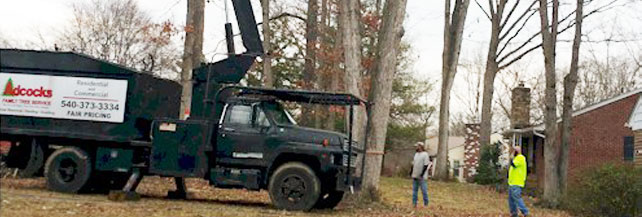
Tree pruning and tree trimming are of the two most common tree maintenance procedures. Periodic pruning and trimming is essential for neighborhood trees to function in their habitat and thrive. Pruning is necessary for several reasons. Sometimes trees have to be pruned to maintain structural integrity. Trees also need to be pruned to create the proper growth pattern and structure that suits the sites conditions. Trees are also frequently pruned to improve aesthetics. All tree trimming and pruning must be done by an individual that understands the biology and physiology of a tree. Improper pruning procedures can create lasting damage and drasticly shorten the tree’s life expectancy. Each cut that is made has the potential to change the growth pattern of the tree and just a single mistake can ruin the tree entirely.
Not every species of tree requires pruning or trimming every year. Although most fruit trees will require proper pruning for maximum fruit yield. For your tree’s safety, it is recommended to have your tree evaluated once a year. A strong tree, properly pruned, is less likely to break branches in adverse weather, also causing possible damage to your property or even you.
Proper tree pruning can also enhance the look of landscaping ideas and give yourself a better view of your own property. Always consider the health of your tree. Trees require the removal of dead wood for maximum growth, also reducing the possibility of carpenter ants living in those branches. It is recommended to prune crossing, broken and diseased branches, therefore adding to tree health. Crossing tree branches can rub together causing open wounds leading to infectious tree diseases. Only a certified arborist can guide you in proper tree trimming and care. Avoid future problems and frustration. Call us once a year for free estimate, evaluation and consultation for your tree care needs.
Tree pruning is a frequently performed tree service practice that provides for healthy tree maintenance. Trees that grow in the wild do well without being trimmed up by man but landscape tree have the need to purposefully pruned in order to maintain their appearance and safety. Properly practiced pruning techniques require a deep knowledge of how trees respond to being cut.
Common grounds for tree pruning include the removal of hazardous or dead branches and to get rid of any rubbing or crowded limbs. Another common reason to prune a tree is to enhance the amount of light and air that is getting to the tree’s crown as well as the ground below it. Usually, the pruning of a mature tree is done to prevent or correct an issue with the tree. Some people believe that regularly thinning a tree will improve its health. Not so. The crown of a tree is made up of thick amounts of leaves whose purpose is to create the sugar that the tree uses as energy to grow and develop properly. When over pruning a tree causes a reduction in this necessary foliage, the tree is adversely affected. It cannot grow properly or store energy as it needs to. This kind of tree pruning causes the tree major stress.
Generally speaking, people like trees. That is why we plant them in our immediate surroundings. However, it is sometimes necessary for us to adapt our trees to the city settings we live in because they do not accurately imitate a tree’s natural growing conditions. They may not be safe, or they may not match our landscaping layouts and lawns. When a tree technician such has a vast understanding of the biology of trees, they can help you meet all your landscaping goals while simultaneously increasing the value of your home and creating a safe and beautiful environment for your trees.
Typical everyday tree pruning with the purpose of eliminating dead, weak or diseased limbs can take place throughout the year at any given time and have no ill affect on a tree. However, it is a known fact that a tree’s wound closure and growth are at their peak when pruning occurs prior to the growth flush of spring.
Certain types of trees, including both birch and maple trees, will actually ‘bleed’ if tree pruning happens too soon in the springtime. Bleeding’ does not harm the tree much but may not be very aesthetically pleasing. When a tree has a known disease, like oak wilt, it is not a good idea to prune it while the disease is in an active state of transmission. Doing so can cause the disease to spread via spores that can now access the tree through fresh pruning wounds. Once the tree is past the active transmission period of the disease, it is safe to prune it. During the spring growth flush, trees use large amounts of their energy to create early shoot growth and foliage. Stay away from having massive tree pruning done immediately after this time. It will cause the tree much stress to have large quantities of foliage eliminated right after it has been produced.